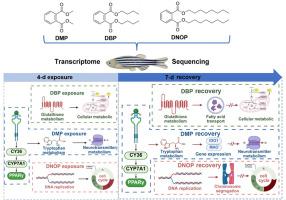Responses of zebrafish to phthalate exposure and recovery: Insights into transcriptome-based molecular mechanisms
IF 7.3
2区 环境科学与生态学
Q1 ENVIRONMENTAL SCIENCES
引用次数: 0
Abstract
Phthalate acid esters (PAEs), widely used as plasticizers, are frequently detected in the environments and are known to exert toxic effects on aquatic organisms. However, whether these effects are recoverable after exposure—and the mechanisms underlying any recovery—remains poorly understood, limiting accurate risk assessment for these toxicants. In this study, zebrafish were exposed to three representative PAEs—dimethyl phthalate (DMP), dibutyl phthalate (DBP), and di-n-octyl phthalate (DNOP)—for 4 days, followed by a 7-day recovery in PAEs-free water. By combining accumulation assessment, survival analysis, and transcriptomic sequencing, we investigated the molecular mechanisms underlying these toxic effects and recovery. All three PAEs were detected in zebrafish during exposure and recovery periods. While no changes were observed in survival, transcriptomic sequencing revealed distinct molecular patterns: DMP interfered with PPAR signaling and tryptophan metabolism, leading to lipid dysregulation, neurotransmitter imbalance, and oxidative stress. DBP influenced glutathione metabolism, reducing antioxidant and detoxification capacity. DNOP suppressed the expressions of genes related to cell cycle and DNA replication, inhibiting cell proliferation and tissue repair. After 7-day recovery, PAE residues were still at high levels, and molecular alterations were aggravated: tryptophan metabolism was further inhibited in the DMP exposure, glutathione pathway remained downregulated under DBP, and DNOP-induced cell cycle arrest became more severe. Our results suggest that PAE exposures can induce persistent and compound-specific transcriptomic toxicity in zebrafish, even after toxicant removal. These findings highlight the importance of including post-exposure periods in future toxicological studies and provide molecular insights for improving environmental risk assessments for PAEs.

斑马鱼对邻苯二甲酸盐暴露和恢复的反应:对基于转录组的分子机制的见解
邻苯二甲酸酯(PAEs)广泛用作增塑剂,在环境中经常被检测到,并且已知对水生生物具有毒性作用。然而,这些影响在接触后是否可以恢复,以及任何恢复的机制,仍然知之甚少,限制了对这些毒物的准确风险评估。在这项研究中,斑马鱼暴露于三种具有代表性的聚苯二甲酸二甲酯(DMP)、邻苯二甲酸二丁酯(DBP)和邻苯二甲酸二辛酯(DNOP)中4天,然后在不含聚苯二甲酸二丁酯的水中恢复7天。通过结合积累评估、生存分析和转录组测序,我们研究了这些毒性作用和恢复的分子机制。在斑马鱼暴露和恢复期间检测到所有三种PAEs。虽然生存率没有变化,但转录组测序揭示了不同的分子模式:DMP干扰PPAR信号传导和色氨酸代谢,导致脂质失调、神经递质失衡和氧化应激。DBP影响谷胱甘肽代谢,降低抗氧化和解毒能力。DNOP抑制细胞周期和DNA复制相关基因的表达,抑制细胞增殖和组织修复。恢复7天后,PAE残基仍处于较高水平,且分子改变加剧:DMP暴露进一步抑制色氨酸代谢,DBP下谷胱甘肽通路下调,dnop诱导的细胞周期阻滞更加严重。我们的研究结果表明,即使在毒性去除后,PAE暴露也可以在斑马鱼中诱导持久性和化合物特异性转录组毒性。这些发现强调了在未来的毒理学研究中纳入暴露后时期的重要性,并为改进PAEs的环境风险评估提供了分子见解。
本文章由计算机程序翻译,如有差异,请以英文原文为准。
求助全文
约1分钟内获得全文
求助全文
来源期刊

Environmental Pollution
环境科学-环境科学
CiteScore
16.00
自引率
6.70%
发文量
2082
审稿时长
2.9 months
期刊介绍:
Environmental Pollution is an international peer-reviewed journal that publishes high-quality research papers and review articles covering all aspects of environmental pollution and its impacts on ecosystems and human health.
Subject areas include, but are not limited to:
• Sources and occurrences of pollutants that are clearly defined and measured in environmental compartments, food and food-related items, and human bodies;
• Interlinks between contaminant exposure and biological, ecological, and human health effects, including those of climate change;
• Contaminants of emerging concerns (including but not limited to antibiotic resistant microorganisms or genes, microplastics/nanoplastics, electronic wastes, light, and noise) and/or their biological, ecological, or human health effects;
• Laboratory and field studies on the remediation/mitigation of environmental pollution via new techniques and with clear links to biological, ecological, or human health effects;
• Modeling of pollution processes, patterns, or trends that is of clear environmental and/or human health interest;
• New techniques that measure and examine environmental occurrences, transport, behavior, and effects of pollutants within the environment or the laboratory, provided that they can be clearly used to address problems within regional or global environmental compartments.
 求助内容:
求助内容: 应助结果提醒方式:
应助结果提醒方式:


